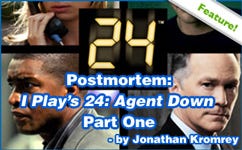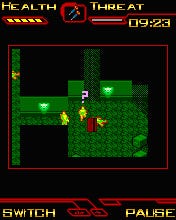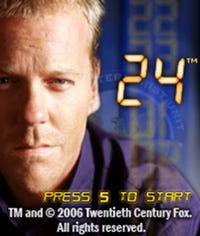GamesOnDeck is proud to present our first postmortem, in which I-play's Jonathan Kromrey describes the development of 24: Agent Down, based on the hit Fox television series 24. Part One discusses "What Went Right."

 [This article can serve as a companion piece to Jonathan's “A Day in the Life” development diary of the original 24: The Mobile Game that appeared on Gamasutra in February 2006. This is Part One, discussing What Went Right. Part Two, published on Thursday, discusses What Went Wrong.]
[This article can serve as a companion piece to Jonathan's “A Day in the Life” development diary of the original 24: The Mobile Game that appeared on Gamasutra in February 2006. This is Part One, discussing What Went Right. Part Two, published on Thursday, discusses What Went Wrong.]
Intro
24: Agent Down is based on the hit Fox television series 24 and is the sequel to the 2006 BAFTA-award-winning 24: The Mobile Game.
This time the race against the clock starts when Jack Bauer responds to an alert from the Counter Terrorism Unit Headquarters (CTU) which has been infiltrated by terrorists who have taken hostages. At risk: the "NOC List" - a file containing all of the names of every US secret agent in the world. As Jack, the player uses a new inventory system to select the right tool (or weapon) for each situation, and with technical help from Chloe (and sniper support from Curtis) he might have a fighting chance to save the day once more.

24: Agent Down
The production of the first game (24: TMG) had a demanding conversion schedule and the process was both thrilling and nail-biting. We were fortunate enough to work with the same talented team from Big Blue Bubble and this time around had a bit more time to create 24: Agent Down (24: AD).
To keep the momentum we generated with the first title, it was only a matter of a week or two after Beta when I sat down with the team at BBB to discuss what we would like to do for the sequel. We started by listening to players' feedback and focus test results on what game elements were their favorites - the shooting game, the car chase sequences, etc. (as well as the least favorite - the lock-pick game and word decryption).Then we discussed the largest development goals (making the player actually Jack rather than the Player as him/herself, a tighter storyline and better integration with the mini-games), along with new publishing, licensor, and sales targets.
The result was a game concept and feature set that was more focused and concentrated, just like the television series. I often referred to it as "a shot of espresso compared to coffee" - it packed a powerful punch for the player and was a fresh approach to a successful series.
What Went Right
1) Bigger and Better, All Around
Okay, so maybe we had a larger cup of espresso than any sane people would consume in one gulp, but both the development team and I were in love with the 24 license and we were determined to make an even better game and experience than the first. Not only did we have to come up with a compelling story, new mini-games, and new ways to increase the quality of the gameplay and graphics from the lowest device up, but we also had to achieve broader publishing goals as well.
Size Matters
It was crucial to give our players as much content as possible in an application which most players do not realize is oftentimes smaller than a single page of a word document (i.e. under 300k of memory) to fit onto their mobile device. For 24: Agent Down we had 243k (max) to 60k (minimum), but with streamlined code from the first game we were able to maximize gameplay on each device set (high, medium, low, extra low, and supporting connectivity with most) we set a design target of a minimum four modes of game play on the lowest devices, and six modes of play on the highest devices.
Language Matters
In games where each letter of each word can have a direct affect on the size of the application, keeping a tight control on the amount of text is crucial. Whereas 24: TMG was developed so rapidly the production team was able only to support one language per device (meaning that our conversion group had 366 English-only versions with a whopping additional 1130+ localized builds - and then have to process and test them in record time), 24: AD had a total of roughly 500 J2ME builds, total, with EFIGS (English French, Italian, German, and Spanish) included. Having been through the pain of the first game we benefited from streamlined localization processes, and faster implementation for language testing.
Support Matters
Not just the game had to work well, but all of the connected / back-end support such as posting high scores, and more. For 24: AD we implemented the new "I-play lounge" game room, added more frequent postings to high-score tables, informative messages to players once high scores are posted, and a demo mode for try before you buy opportunities - all extra twists to enhance game play and improve the overall quality of the 24 experience.
First Impressions Matter
From the opening splash screen we established the fact that we made a significant graphical improvement to the game. Instead of a single character, the player sees an animating splash akin to the beginning of the television series. This was a huge step up in the perceived quality of the game and whetted the player's appetite to see more.


Left: The 24: The Mobile Game Splash Screen
Right: The 24: Agent Down Splash Screen
2) The Stage within a Stage
Where its predecessor was more of a "choose your own adventure" style of gameplay which took the player to various locations (the San Diego Naval yard, secret warehouses, highways, a SAT-COM map of the city, etc.), one of the most important (and challenging) changes was to present the player a consistent game stage in which the story could unfold yet still retain a high level of variety and a seamless flow of events. To do this the player assumed the role of agent Jack Bauer and we compressed all of the action to the depths and inner secrets of the mysterious and government headquarters of the CTU.
Not only was the choice to have the player actually "be" Jack (something we had heard players wanting to do in the first game), but to be inside CTU was like being a kid in a secret-lair candy shop! With help from the 20th Century Fox Mobile group as well as 24 show writers and producers, we were given a tour of the 24 set that involved schematics and details about CTU that we still cannot reveal (or we'd find ourselves killed - shh!). Let's just say that we discovered that there's a lot of CTU that the general public doesn't know about!
This decision led to the creation of the Action/Adventure mode - or, simply put, playing Jack as he moves through CTU to solve missions. While it was most similar to the "Infiltrate" mini-game from 24:TMG - where players only needed to avoid detection from hostiles to get to the lit goal area in the time allotted - in 24: AD this game was retooled with engine improvements, new enemy AI, and other features so that it could hardly be called a sub-game, but a full game mode in its own right.
3) Solid Set of New Features
Not only are we fans of the show but as gamers we wanted to challenge ourselves to raise the bar again in terms of creating new gameplay mechanics, a compelling story, and a list of features that, when combined with the other elements, formed a cohesive and knock-out game experience.
• Crisper, brighter graphics throughout - more polished and "cool" look to everything from mini-games to menus
• Animated front-end (splash screen) modeled after the television series
• Free Movement vs. grid-based movement of the previous game
• Context sensitive actions such as opening doors, activating computer terminals, knocking out terrorists and dragging their bodies into shadows as to not alert other terrorists.
• New Inventory system where items can be picked up, dropped, and used (for all devices)
• New "Search and Rescue" Missions with different ways to win
• New story and more intrigue with the shows' favorite characters
• High replay value as players try to beat their fastest time
• Mini-games are all unlocked and can be played outside of the Story Mode
• For connected devices: online posting of fastest time completed (Sprint Game Lobby and MRC enabled)
• Four game modes for the s40 (low-end devices): Infiltrate / Sniper Zoom, Spinlock, and Code Crack
• Additional game modes for the s60 (high-end devices), as above, but with Surge, Bomb Trap, and Cyber Link
4) Lots of Prototyping and Design (and Balancing - oh My!)
Once it was apparent that there was not enough room for the driving game (my particular favorite part of 24: TMG) we focused on packing as much as possible in to the Adventure Mode with its 3/4 SATCOM view, sniper mode, interactive items, and new inventory system (and more!). Over a space of three weeks we spent a lot of time creating new mini-games that would fit into the world of 24 and progress the plot. We also paid close attention to how the game play information and mechanics would be presented to the player. Drawn-out training missions from the first game were replaced with more finely-tuned versions in 24: AD, then, with the help of a dedicated level designer the levels were tuned to ramp up in difficulty as the story progressed.


Adventure Mode / Sniper Mode
Seen through the mile-high eyes of SATCOM the player sees a heat image of Jack and enemy targets within the depths of CTU. Enemy bodies can be picked up and dragged out of line-of-sight detection areas, items such as key cards and health packs picked up, and decoys set in place - then detonated. In Sniper Mode the player sees through Curtis' eyes, using a high-powered rifle with bullets that can shoot through walls.

Spin Lock
The lock picking from the first game was a test of logic. In 24: AD, locks in a level can be picked if Jack doesn't have the key. This new mini-game is a quick test of timing and reflexes that keeps with the pace of the rest of the game.

Surge Mode
This mini-game is a test of logic that is meant to be faster paced than the logic puzzles in the first game. It is most similar to the bomb-diffusing game from 24: TMG.

Code Break
A more simplified version of the lock-pick game was needed, so with Chloe's help Jack can access the re-configured security pads and - if he's quick enough - gain access.

Bio-hazard Bomb Disposal
Naturally, in CTU there is a lot of ultra-secret and extremely fatal secrets - and then there are the booby traps that the terrorists set up! For this trap Jack controls the Bio-hazard Bomb Robot in a separate area by remote to strategically move the bombs into safe-zones. Expandable difficulty with bomb placement and variety (i.e. nerve-gas bombs have to be disabled first, etc.) was planned, but discarded to keep the game simple, yet challenging with different maze designs.

Cyberspace Chase
Ala Neuromancer Jack has to control a "fake code module" through the CTU firewall and anti-virus systems, hopefully avoiding detection so he can swap the fake information with the NOC list and foil the nefarious plans of the bad-guys.
5) Seamless QA, Localization and Conversion
Whereas most of the focus of game development is typically measured with the core development team and reference stage (concept, 1st playable, Alpha, Beta, and Gold Master), it truly is only half of the solution. With a staggering and mind-numbing variety of screen sizes, certification requirements, and available memory limitations on literally hundreds, if not thousands, of devices supporting different languages all over the world, the success of 24: AD and all I-play games is dependent on the localization, quality assurance, and conversion groups. To that end, we used a consistent method of status reporting, global test tracking, and constant communication threads which were updated as often as every twelve hours, daily, over a period of several months. In the end, the product was completed in record time and within budget.
[Jonathan Kromrey, or "Krom" as he's known by friends and colleagues, is a producer at I-play (www.iplay.com), a leading publisher of mobile games like 24, The Fast and the Furious, Jewel Quest, and Skipping Stone, chosen as "Game of the Year" at the 2005 Mobile Choice Awards. Jonathan has produced, directed, written and developed games for all platforms over eleven years for companies such as Strategic Simulations Inc., The Learning Company, Mattel Interactive, Namco, Eidos, and I-play.]
[This is Part One of a two part postmortem, discussing What Went Right. Part Two, published on Thursday, discusses What Went Wrong.]
Read more about:
FeaturesAbout the Author(s)
You May Also Like








